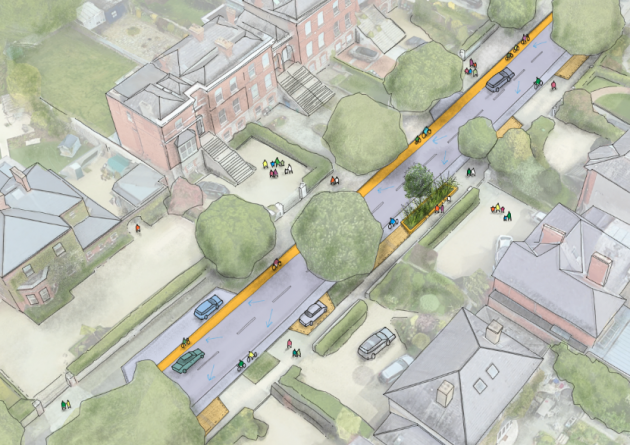I was at a meeting in March organised by the Protection of Water Bodies office in Dublin City Council, to discuss two new trials of Sustainable Drainage Systems (SuDS) along the Dodder.
As part of the EU Water Framework Directive, all rivers, lakes, and coastal waters are assessed, and given a grade from High to Bad. A High quality river has clean water, and a healthy ecosystem in and alongside the river. The Dodder is only at Moderate status, and needs to be brought up to at least Good.
When landscape is in a natural state, most rainwater is absorbed by the ground, and makes its way into rivers very slowly.

We’re all familiar with the fact that deforestation leads to flooding – when trees are cut down and the land is cleared, it won’t hold as much water. When it rains, the water flows into the rivers too quickly, causing flooding downstream. In rural areas, we’ve drained wetlands, removing a natural sponge, and water flowing off grasslands often carries nutrients from fertiliser, causing algal growth in rivers and killing fish.

In urban areas, rainwater runs straight off concrete and tarmac into drains. Too much rainwater – and at this stage it doesn’t take much – and the rainwater spills over into the sewage system and washes that into the river. But even ‘pure’ rainwater is carrying rubber particles (from car tyres) and other surface pollutants into the river.
So, the aim of a sustainable drainage system is to slow the movement of rainwater into the rivers, to stop flooding and mixing with sewage, and to filter the water on the way. There are two prototype developments being worked on along the Dodder river, both of which should start construction in late 2023 or early 2024.

All of the rainwater on Eglinton Road flows into a single storm drain, which then flows into the Dodder. At the moment, all of the surfaces on the road are hard – concrete and tarmac – and the water flows right off. The proposal is to install permeable surfaces on the cycle lanes and parking spaces, allowing water to soak into the ground. More soil will be exposed around trees, and there will be new planting, also allowing water to soak in. Some water will still make its way into the storm drain, but at a slower rate, and the plants and soil will filter out some of the particle pollutants.

Milltown Road is closer to the Dodder, and right now rainwater flows directly from the gutters through a drain into the river. The proposal is to direct the water into shallow ditches and basins in the park. Water will collect in these areas during wet weather, soak into the ground and be absorbed by plants. Less water will flow into the river, and the plants will benefit from having water available during dry spells.
Other trials are going ahead on the river Santry (which has worse water quality). These nature-based solutions can then be applied all across Dublin, and help us restore life to our rivers.
